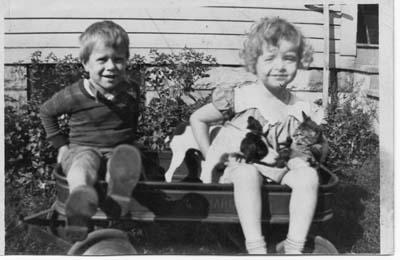|
Prologue I was born in Cleveland, Ohio, July 28, 1930, the third and last child in a family that was, as my father put it, two potatoes away from being dirt poor. For those days, at the beginning of the Great Depression, that was not too bad.
Though my childhood was fenced in by poverty and I knew the ungenerous consequences of class, it was, to paraphrase from my favorite novel, "the worst of times, it was the best of times." I grew up in a cocoon, an Irish Catholic Parish. This is a memoir about growing up Catholic but it has nothing to do, or everything to do, with religion. I recall serving mass, Latin exchanges between priest and altar boys, but I have a fond memory of Sister Principia helping me keep my fingernails clean enough for the altar. I recall seeing nuns kneeling for hours in front of the Blessed Sacrament praying for our servicemen during World War II, but the memories that make me smile are of nuns teaching us to roll bandages and taking us to Crile Military Hospital where we wrote letters home for soldiers too injured to do so for themselves while sisters entertained with piano, banjo and singing. Our priests were dominating spiritual figures. Only they could open mass with "Dominus Vobiscum," dispense Holy Communion, declare couples married in God's sight, forgive sins in confessional. My warm memories are of a priest with a wonderful sense of humor, another who let us play basketball in the gym when it was officially closed, and another who could talk to us outside the confessional. My wife, Pam, inspired this memoir. We'd been watching a PBS special on "The Irish in America," which I dismissed as "only a few clips of Kennedys and their sort, nothing on Irish parishes where Irish became Americans, a fraud." I was ready to roll but was intercepted by one of her husband-handling skills; she suggested I write something about my recollections. She calls this her "safer-in-his-study" approach. But she went on, "I really mean it. Your recollections of parish life aren't covered in anything I've read. They should be." Pam's family produced a long line of American Congregational ministers from the 18th to mid-20th century. She's a serious reader of American history and has worked as an 18th century historical interpreter for the Colonial Williamsburg Foundation.
Her innocence regarding Catholic parish life is unsurprising. Students of American history know a good deal about Protestant, and little about Catholic, history. When Pam's mother was a young girl living in a Congregational Church parsonage in Canaan, Connecticut, she was not allowed to play with Irish Catholic children. Pam's only experience with Catholic schoolchildren and nuns was when her very-Anglican school played basketball with one of New York City's Catholic schools. "It seemed grossly unfair," she recalls, "to see little old ladies dressed as penguins crossing themselves when one of their school's children went to the foul line. We never could beat them." In turn, if my experience was typical, Catholic schools taught little about Protestantism and discouraged dating Protestants. When I was old enough to think about Martin Luther I saw him as a priest who had to start a new religion because he wanted to marry a nun. There are some commentaries and fictional depictions of parish life. I found a few interesting oral histories, but they are more like snapshots than pictures and are difficult to access. There's an excellent University of Notre Dame broad-sweeping historical-sociological study. In his novels, author Father Andrew M. Greeley puts human faces on Catholicism and provides glimpses of parish life. Though Greeley grew up in a south Chicago Irish parish I've not found any discussion of that experience in his writings, though he does often comment on how it affected him. I've tried to render happenings and remember voices accurately from around 1936 to 1944, when I was at St. Aloysius School, but I'm aware memory has a way of ripening into nostalgia and, as Emerson said, "the years teach much which the days never know." TABLE OF CONTENTS | NEXT CHAPTER |
